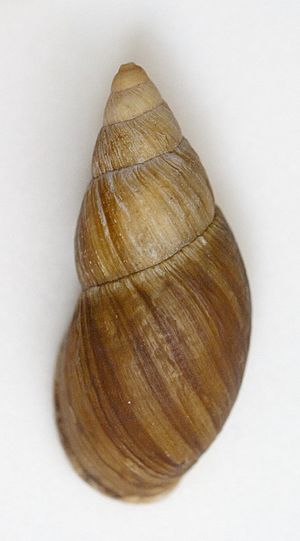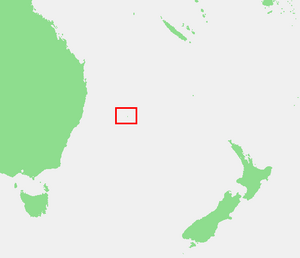Lord Howe flax snail facts for kids
Quick facts for kids Lord Howe flax snail |
|
|---|---|
 |
|
| Conservation status | |
| Scientific classification | |
| Kingdom: | |
| Phylum: | |
| Class: | |
| (unranked): |
clade Heterobranchia clade Euthyneura
clade Panpulmonata clade Eupulmonata clade Stylommatophora informal group Sigmurethra |
| Superfamily: |
Orthalicoidea
|
| Family: |
Bothriembryontidae
|
| Subfamily: |
Placostylinae
|
| Genus: |
Placostylus
|
| Species: |
P. bivaricosus
|
| Binomial name | |
| Placostylus bivaricosus (Gaskoin, 1855)
|
|
 |
|
| P. bivaricosus is endemic to Lord Howe Island | |
The Lord Howe flax snail, also called the Lord Howe placostylus, is a very large land snail. Its scientific name is Placostylus bivaricosus. This special snail breathes air and is a type of gastropod mollusc. It belongs to the family Bothriembryontidae.
This big snail lives only on Lord Howe Island. This island is off the east coast of Australia. The snail's numbers have dropped a lot. It used to be common, but now it is an endangered animal. This happened after rats were accidentally brought to the island in 1918. Lord Howe Island is a special World Heritage island.
Contents
Types of Lord Howe Flax Snails
Scientists divide the Lord Howe flax snail into different types called subspecies. These are slightly different groups within the same species.
- Placostylus bivaricosus bivaricosus (Gaskoin, 1855)
- Placostylus bivaricosus etheridgei (Hedley, 1891) - This type is now extinct.
- Placostylus bivaricosus cuniculinsulae (Cox, 1872)
- Placostylus bivaricosus solidus (Brazier in Etheridge, 1889)
What Does the Lord Howe Flax Snail Look Like?
The Placostylus group of snails are large snails that live on the ground. They are found in different places across the South West Pacific. These places include the Solomon Islands, Fiji, New Caledonia, Lord Howe Island, and the top part of New Zealand.
The Lord Howe flax snail has a brown shell. Its shell is pointed and can grow up to 7 cm (about 2.7 inches) long. It can also be about 2 cm (0.8 inches) wide.
Protecting the Lord Howe Flax Snail
Why the Snails Are Disappearing
Old stories and fossils show that the Lord Howe Island flax snail used to be everywhere on the island. There were many of them. But in the 1940s, people started to notice that their numbers were going down. Now, this snail is listed as critically endangered. This means it is very close to disappearing forever.
The black rat is thought to be the main animal that hunts and eats these snails. Rats are a big danger to the snail's survival. Other birds, like European blackbirds and song thrushes, might also eat the snails. These birds arrived on the island around 1950.
Other problems also make the snail's numbers drop. These include clearing away their homes (habitat clearing). Changes to their living areas and disturbances also hurt them. Even chemicals like herbicides and pesticides might be a problem.
Helping the Snails Recover
In 2001, a special plan was made to help protect and bring back the Lord Howe Island flax snail. This plan is called a recovery plan. The plan includes several important actions:
- Surveys: Looking for snails and their homes to see where they live and how many there are.
- Awareness: Teaching people in the community about the snail and why it needs help.
- Captive-breeding program: Raising snails in a safe place, like a special zoo, to help their numbers grow.
The Lord Howe Island Board is in charge of making this recovery plan happen. They have built a special area that rats and birds cannot get into. This is for the snail project. The first baby snails born in this safe place have already hatched!
For two years, schoolchildren will help with this project. They will watch the snails and their eggs very closely. They will also measure how fast the young snails grow and how many of them survive.
To save this snail in the wild for a long time, it is very important to control or get rid of all the rats on the island.


